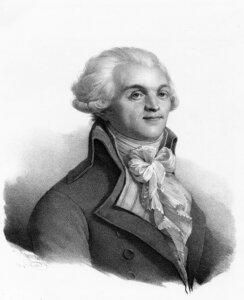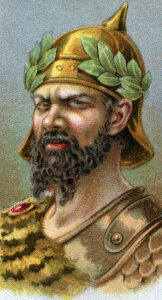Donald Trump speaks to the media as he walks to board Marine One at the White House. Photo by Getty Images
Never heard of Jan Bockelson? Or Georges Boulanger? You’re not alone. But Attila the Hun, Genghis Khan, Robespierre and the Roman emperor Nero are all names that you are likely familiar with. And they are among the historical figures with whom Adolf Hitler was compared during his time.
Eighty years after Hitler died by suicide, America’s 47th president — Donald J. Trump — is trying to use authoritarian muscle to bend the nation to his will. With Trump acting more like an authoritarian in his second term than he did during his first, it can be instructive to take a look at the villains that Hitler was compared to before his rise to power, during World War II, and after the fall of the Third Reich. And maybe begin to ponder: What will Trump’s place be in history’s rogues’ gallery?
During his early years with the Nazi party in Munich of the early 1920s, Hitler cut a laughable figure — a failed artist who went around wearing shabby clothes and acted like a madman at political rallies. He was even an embarrassment for some Nazis. Kurt Luedecke, one of Hitler’s earliest acolytes, described watching Hitler “take out of his pocket a piece of greasy sausage and a slice of bread, and bolt them while he talked.” So it should be no surprise that Hitler in those days was not seen as a serious politician, much less a threat to democracy.
That changed after the Nazis won more than 18% of the vote in the Reichstag election of 1930, according to historian Gavriel D. Rosenfeld.
“From this point on, journalists and other observers began to take Hitler more seriously and began to subject him to historical comparisons,” Rosenfeld wrote in a 2018 scholarly paper titled Who Was “Hitler” Before Hitler? Historical Analogies and the Struggle to Understand Nazism, 1930-1945.

One of the first analogs was Georges Boulanger, a 19th century French general who contemplated toppling the leaders of France’s Third Republic and imposing a dictatorship. According to Rosenfeld, in 1931 the Brooklyn Eagle newspaper called Boulanger “the ‘Hitler’ of his day.”
Others thought Hitler had more in common with Maximilian Robespierre, the French revolutionary leader who started out as a passionate advocate for democracy but became increasingly authoritarian. Thousands were executed by guillotine during the Reign of Terror, a bloodbath justified by Robespierre as essential for preserving the purity of the revolution.
In the early 1930s, some observers thought Hitler would be capable of such massacres. That proved true after Hitler rose to power and in the summer of 1934 ordered the “Night of the Long Knives” in which at least 85 people Hitler viewed as threats were killed. The main flaw in comparing Hitler with Robespierre is that the latter was never a champion of democracy. The Robespierre analogy also vastly underestimated Hitler’s potential for carrying out the mass murders and carnage that were wrought during the Third Reich.
During his first years as German chancellor, Hitler was also compared to Napoleon III. Born Charles-Louis Napoléon Bonaparte, the nephew of Napoleon Bonaparte, he was elected President of France in 1848, imposed authoritarian rule, and declared himself emperor in 1852.
Hitler’s first years in power, according to Rosenfeld, also drew comparisons to Henry VIII, Oliver Cromwell, Julius Caesar and Nero. Quite possibly the most obscure historical personality to have been compared with Hitler was Jan Bockelson, a 16th-century, Dutch-born radical and a key figure in an Anabaptist rebellion in the German city of Münster. Terror was used to create a theocratic state the Anabaptists called New Jerusalem, and Bockelson was proclaimed King of Münster. The rebellion was crushed by Catholic forces. Bockelson and two other leaders were tortured and killed. Their bodies were placed in iron baskets and hung from a church steeple. Their bones are no longer there, but the baskets are.
Hitler’s invasion of other countries and his increasingly clear plans to exterminate Jews drew comparisons with the bloodthirsty Persian empire official Haman, with Nebuchadnezzar II, Philip of Macedon, Hannibal, Attila the Hun and Genghis Khan.

During his research, Rosenfeld found that the liberation of the Nazis’ death camps and concentration camps — scenes of dead and dying prisoners, mass graves, gas chambers, and ovens for burning bodies — profoundly changed views on making comparisons between Hitler and earlier historical figures. Hitler came to be seen as the embodiment of pure evil, his crimes unequaled in all of human history.
Every time a new villain arises on the world stage, such as Cambodia’s Pol Pot and Uganda’s Idi Amin, comparisons are inevitably made with the Nazi leader. Modern-day massacres and genocidal acts are compared with the crimes of the Nazis.
Which brings us to Donald Trump.
In an interview, Rosenfeld told me that American democracy has previously seemed to be in peril, such as in the late 1960s and early 1970s — with race riots, campus protests, political assassinations, the Kent State shootings, the Vietnam War, and the Watergate crisis. During that period, parallels were being made to the Weimar Republic.
“In some ways I think that era was even worse than what we’re in the middle of. I hope that era stays worse,” Rosenfeld said.
“We’re definitely in an authoritarian moment,” he added. “I think most people today would say however much Trump might have fascist tendencies we are still a flawed but nevertheless liberal democratic state.”
But we don’t know where America is headed. Trump has taken many legal losses as courts rule against his drive to increase his powers. But he has not given up. He has ignored court orders and appealed court decisions that reject his power grabs. A lot of this will end up in the Supreme Court. But he’s already caused a lot of damage that will be difficult to undo. Despite his bluster about annexing Greenland and Canada and taking back the Panama Canal, he does not seem to possess the kind of lust for conquest that drove Adolf Hitler and other tyrants of history.

But things can change in a heartbeat.
Will Trump suspend habeas corpus, as his foot soldier Stephen Miller has proposed doing? What if he finds some provocation to declare martial law? Clashes between federal immigration agents and protestors in Los Angeles over the past few days may be a foretaste of uglier things to come. Trump has ordered 2,000 California National Guard members to quell the protests. California Gov. Gavin Newsom said Trump’s order was “purposefully inflammatory and will only escalate tensions.”
Trump has already shown what he is capable of. His fanatical followers stormed Congress on Jan. 6, 2021, incited by Trump as he sought to stay in power after losing the election to Joe Biden. He is only at the start of his second term, but he’s put cracks in the foundations of democracy with his assaults on the rule of law, the Constitution, higher education and the free press. He’s brought turmoil to international trade relations. He embraces the world’s despots and voices disdain for America’s closest allies.
With that record alone, Trump certainly has earned a spot in history’s rogues’ gallery. And he’s only just begun.
